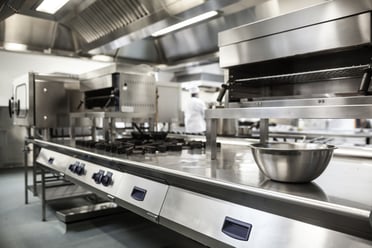This article was featured in QSR Magazine
The ability to capture, utilize, and implement data in the kitchen is immense, yet completely underutilized.
For more than two decades, the restaurant sector has been on an incredible run of innovation, the likes of which the industry has never seen. The modern restaurant operation bares almost no resemblance to the institutions of the past, and the list of innovations and transformations now in the hands of restaurant management runs long and wide.
Some of these innovations are institutional. New categories like fast casual have emerged. Restaurant menus have embraced new cuisines, both international and experimental. The farm-to-table movement has influenced new standards in menu transparency.
Advancements in technology have also played a dramatic role, specifically in ordering technology and how consumers receive their food. The tech landscape in restaurants now boasts multiple devices to receive online orders, host stations displays, bright large touch-screen menus, and even electronic ordering stations that entice diners with delicious imagery and a plethora of “would you like fries with that” options. The latest offerings promise to recognize a consumer from their license plate and have their favorites ready even before they pull up to order. 
The pandemic merely accelerated these changes, and the Restaurant 2.0 phase of the food service industry has led to incredible advancements. Over the past 20 years, leaders in the industry have demonstrated the success of investments in POS, online ordering, loyalty, delivery and other consumer-facing/transaction-driving improvements.
And yet, this transformation feels incomplete. Operators have mostly focused on front-of-house technology, a direct response to the changing needs and demands of their customers. But there remains a core piece of the restaurant operation that represents the next great frontier of innovation, one that may hold the key to drive a real step-change in economic improvement.
The next wave, the Restaurant 3.0 of innovation, must take place in the restaurant kitchen.
When looked at holistically, restaurant kitchens, and how food is made in them, have really not changed in over 25 years. The typical restaurant kitchen—even the ghost version that has emerged of late—has largely remained the same. A POS brings in orders, and kitchen staff completes them. Most kitchens use Kitchen Display Systems (KDS) to show how many items to make and how best to organize orders for the expeditor.
But the modern restaurant, featuring so much technology to add efficiency in the front of house, is still lacking the same in the back of house. And that’s led to wasteful operations and inconsistent preparation.
The ability to capture, utilize, and implement data in the kitchen is immense, yet completely underutilized. Currently, daily estimates on how much food should be prepared, what ingredients are required and when food prep is needed are limited. This inevitably leads to a significant percentage of food waste, or the reliance on less fresh offerings on a menu. It might not matter if the shelf life of items is long or the freezer is deep; today’s eaters look at both things with disdain.
Add to this the myriad new channels of consumer demand, and a changing landscape on how diners look at eating in public places, and you have an emerging challenge. If you want to serve the freshest food, sourced locally and often without additives that will prolong shelf life, there needs to be a greater urgency to look towards the kitchen itself in the next wave of technology investment.
This may seem anachronistic at first glance. Technology may sound synonymous with a cold manufacturing mindset, and we’re now talking about reversing much of the industrialization of the food supply chain, to start going back to the roots of fresh and local.
But technology in the kitchen can directly support that mission. The best manufacturing companies have devoted their efforts in areas that should sound surprisingly familiar to the restaurant industry of today, eliminating waste (green!), improving cycle time (quick!), and reducing inventory (fresh!). And they are now using a whole new set of tools to achieve those goals. We need to do the same in our kitchens, utilizing real-time technology to help our kitchen staffs produce the best possible food with the lowest amount of wasted time and resources.
In fact, adopting these techniques could become a key differentiator for restaurants, implementing systems to help deliver a healthy, local and zero waste value proposition while increasing productivity and profitability.
The technology exists and is ready to be put to work, provided operators revisit the strategic prioritization of tech investment towards the back of the house. And we should be inspired by the possibilities that shifting our focus can provide. Our kitchens came remain sources of culinary creativity and execution while also maximizing efficiency and sustainability.
Note: This is part one in a three-part series. Part 2 will focus on how kitchen tech can enhance human productivity.
Jayson Tipp is a nationally recognized business leader and innovator in the restaurant industry. An insightful strategist and analyst, his core strength lies in leveraging analytics and creativity to devise and execute winning strategies that drive growth. Jayson has served in leadership roles at prominent national chains including Papa Murphy’s, Redbox, Coinstar, Potbelly Sandwich Works, and Starbucks Coffee. Today, Jayson is the Chief Growth Officer at Perfect Company, a leading provider of technology solutions addressing operational challenges for the restaurant and hospitality industries. Jayson is a sought-after industry adviser working with private equity firms and restaurant tech startups like Bridg and GoTab.




